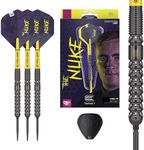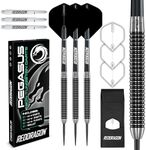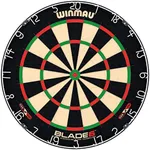Buying Guide for the Best Darts
Choosing the right darts can make a big difference in your playing experience, whether you're a beginner or looking to improve your game. The best darts for you will depend on your throwing style, comfort, and the type of dartboard you use. It's important to understand the main features of darts so you can select a set that feels right in your hand and helps you play your best.WeightThe weight of a dart is one of the most important factors to consider. Darts typically range from about 12 grams to 30 grams. Lighter darts (12-18 grams) are easier to throw quickly and may suit players with a fast, light throwing style, while heavier darts (24-30 grams) can offer more stability and may be better for those who prefer a slower, more controlled throw. Most players find a comfortable middle ground around 20-24 grams. To pick the right weight, think about your natural throwing motion—if you tend to throw hard, a heavier dart might suit you, while a lighter dart can help if you have a softer throw.
Barrel MaterialThe barrel is the main body of the dart and is usually made from brass, nickel-silver, or tungsten. Brass is affordable and good for beginners, but it's less durable and bulkier. Nickel-silver is a bit more durable and still budget-friendly. Tungsten is the most popular for serious players because it's very dense, allowing for a slimmer dart that can group closely on the board. If you want a dart that lasts and feels professional, tungsten is a great choice, but for casual play, brass or nickel-silver can be just fine.
Barrel GripThe grip refers to the texture and shape of the barrel, which affects how the dart feels in your hand. Some barrels are smooth, while others have knurled or ringed patterns for extra grip. If your hands tend to get sweaty or you want more control, a dart with a pronounced grip can help. If you prefer a smoother release, a less textured barrel might be better. Try different grips to see what feels most comfortable and secure for your throwing style.
Shaft Length and MaterialThe shaft connects the barrel to the flight and comes in various lengths and materials like plastic, aluminum, or carbon fiber. Shorter shafts can make the dart more stable and are good for players who grip near the front, while longer shafts can help with a smoother flight and suit those who grip further back. Plastic shafts are lightweight and inexpensive, but can break more easily, while aluminum and carbon fiber are more durable. Choose a shaft length and material that balances well with your grip and feels comfortable during your throw.
Flight Shape and SizeThe flight is the fin at the back of the dart and helps stabilize it in the air. Flights come in different shapes and sizes, with standard flights being the most common and providing the most stability. Slimmer flights are better for faster throws and can reduce air resistance. If you throw with a lot of force, a smaller flight might suit you, while a larger flight can help if you have a slower, more arched throw. Experimenting with different flight shapes can help you find the best match for your style.
Point TypeDarts can have either steel tips or soft tips. Steel tips are used for traditional bristle dartboards and are more durable, while soft tips are designed for electronic dartboards and are safer for home use. Make sure to choose the point type that matches your dartboard. If you play in leagues or at pubs, steel tips are usually required, but for casual or family play at home, soft tips might be the better option.













